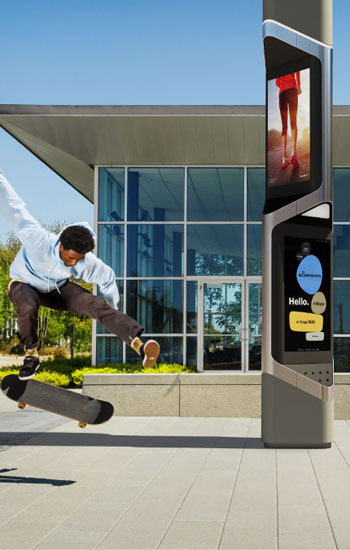Some designers and engineers want to bring high-speed Wi-Fi to as many public parks and plazas as possible. But instead of expanding the style of the unobtrusive yet freely-available Wi-Fi found in New York City's Bryant Park, they want to make a statement with advertisement-laden towers that appear to be about 15-feet tall and could be used to charge your phone or access useful neighborhood information via a high-tech interface, a sort of modern-day bulletin board. Their thinking is these towers will act as beacons to attract visitors, who can interact with them 24-7. In a session at SXSW Interactive in Austin, Texas, Randy Ramusack, founder of LQD Wifi, Daniel Hotlzman with Frog Design, and Francesca Birks with Arup discussed this possible vision of "smarter public spaces" created through LQD's Palo.
Computing has rapidly evolved over the past few decades. Mainframes found in big data centers have morphed into hand-held mobile devices supported by cloud-based data services. "But the cloud is not helping communities," asserted Ramusack. "More neighborhood information is needed to boost community interaction."
He explained that when he picks up one of those free neighborhood newspapers to find out what's going on in the part of New York City he lives in, he goes to more local events. So what if a glowing tower in the park showed you ads about those events, or even pushed you notifications as you walked by?
And LQD Palo could also address more basic equity issues. Vast number of people in cities still don't have Internet access at home. In New York City, about a third of the population does without. What if these people could go to this interactive kiosk to do basic job searches? This is what Ramusack envisions for the future.
The interaction with these smart towers will also need to be two-way, said Holtzman, with Frog Design, which designed the Palo. He thinks the high-speed connectivity these towers offer can only "further enhance the social activities that already happen in public spaces." But others may say that it will only drive people to spend more time on their devices, sitting alone yet together, which is now a sad but common sight in so many public spaces.
Holtzman said these interactive kiosks need to be urban and contemporary but also customizable so they fit the feel of a city and perhaps the public park or plaza they inhabit. He even sees them doing well on streets or in malls and college campuses. Advertisements would be needed to finance the systems, which can't be cheap. According to Ramusack, "targeted advertisements are viewed as less annoying, so Palo needs to display ads relevant to the places they are in."
There are also security and privacy issues that will have to be addressed. Today, Wi-Fi hotspots are dangerous zones for transferring personal data. But Ramusack was optimistic these issues can be fixed and thinks implementing these high-profile devices would be a huge win for any city's mayor. "Tech can make you look good. Wi-Fi gets you re-elected." Old pay phones are already becoming Wi-Fi hubs, at least in New York City. Link NYC will replace 7,500 pay phone booth with free Wi-Fi stations, local phone calls, and phone charging.
Palo may be better suited for the streets than the middle of Central Park. Who wants to see large flashing ads in the middle of their peaceful respite from the city? Likely no one. But they could be a draw if well-incorporated into plazas and put near existing park facilities, like perhaps the bathrooms.

